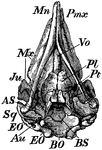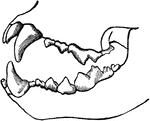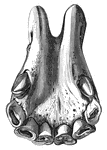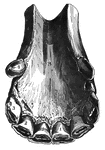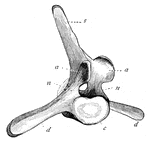The Mammal Anatomy: Skeleton ClipArt gallery provides 277 views of bones, teeth, and skeletal system of various mammals.
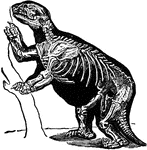
Giant Sloth
"Sloth is the popular name for any individual of the Edentate group Tardigrada, from their slow and…
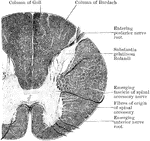
Spinal Cord
Section through the upper part of the cervical region of the cord of an orangoutang. Showing the origin…

The Lower Jaw of a Squirrel
The backward and forward movement of the jaws and the great size and strength of the lower jaw, adapt…

Stag Horns
"The annexed cut represents the horns of the stag at different ages. During the first year, there is…

Stifle Joint Ligaments
Ligaments of the stifle joint- antero-internal aspect. Labels: a, internal lateral femoro-tibial ligament;…
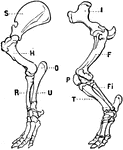
Tapir Legs
"Fore and Hind Leg of a Tapir. A, scapula; I, ilium, or shinbone of pelvis; H, humerus; F, femur; O,…
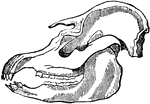
Tapir Skull
This illustration shows the skull of a tapir. Tapirs are large browsing animals, roughly pig-like in…

Tarsus Ligaments
Ligaments of the tarsus- postero-internal view. Labels: a, internal lateral ligament; b, calcaneo-cuboid…

Tarsus Ligaments
Ligaments of the tarsus- antero external view. Labels: a, external lateral, and b, oblique ligament.

Tarsus of a Horse
Bones of left tarsus of a horse, seen from in front and outside. Labels: 1, calcaneum; 2, astragalus;…
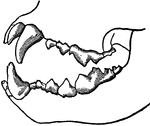
Teeth of a Carnivorous Animal
Teeth of a carnivorous animal that lives on flesh alone. The front teeth are designed for tearing, while…
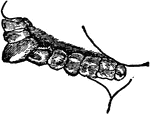
Teeth of a Frugivore
Teeth of a frugivore (fruit-eating animal). Animals that live on soft fruits do not need such grinders…

Teeth of Man and Several Animal Species
1. Dentition (teeth) of man. 2. Dentition of hyena. 3. Dentition of pig. 4. Dentition of Patagonian…

Chimpanzee Teeth
Teeth of the right side of the lower jaw of the Chimpanzee. (i) incisors; (c) canine tooth; (pm) premolars;…

Development of Teeth
The first step in the development of teeth consists in a downward growth from the Rete Malpighi or the…

Incisor and Canine Horse Teeth
Incisor and canine teeth of a horse. A, front, B, lateral, and C, corner incisor; D, canine teeth.

Jaws of a Tiger
Jaws of a tiger, showing that when the jaws are closed the ends of the teeth do not press upon the ends…

Tinoceras
"Tinoceras, or tinotherium, is a genus of mammals now extinct, found in the Eocene, and representing…

Horse Incisor Tooth
Incisor tooth of a horse-posterior view. Labels: a, outer layer of enamel; b, inner layer of enamel…

Premolar Tooth
Section through a premolar tooth of a cat still embedded in its socket. Labels: 1, enamel; 2, dentine;…
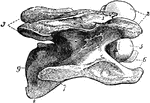
Cervical Vertebra of a Horse
Right lateral view of a cervical vertebra of a horse. Labels: 1, neural spine; 2, anterior oblique processes;…
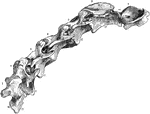
Horse Vertebral Column
Right lateral view of the cervical portion of the vertebral column of a horse. 1 to 7, the seven segments;…
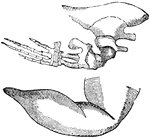
Whale Flipper
This illustration shows the flipper of a whale. The whales use their flippers to propel themselves through…

Whale Forelimb
"Left fore-limb of Balaenoptera. Sc., Sca pula with spine (sp.); H., humerus; R., radius; U., ulna;…

Greenland Whale Pelvis
"Pelvis and hind-limb of Greenland whale (Balaena). P., Pelvis; F., femur; T., tibia." -Thomson, 1916
